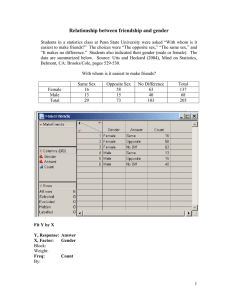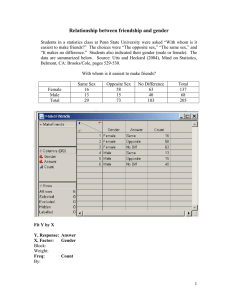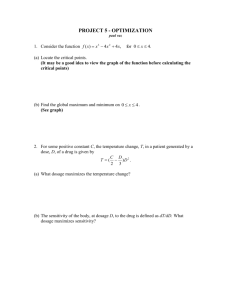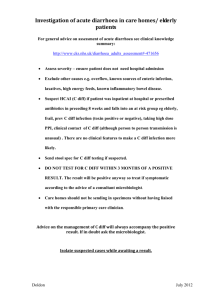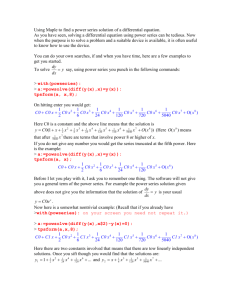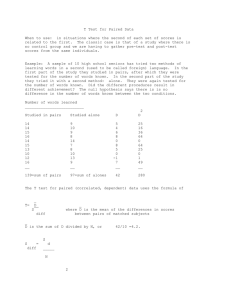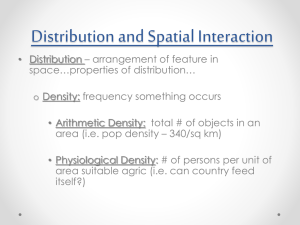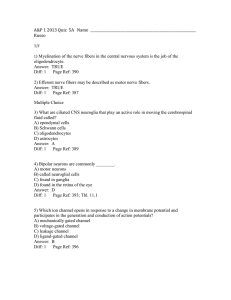Lesson 26 - EngageNY
advertisement
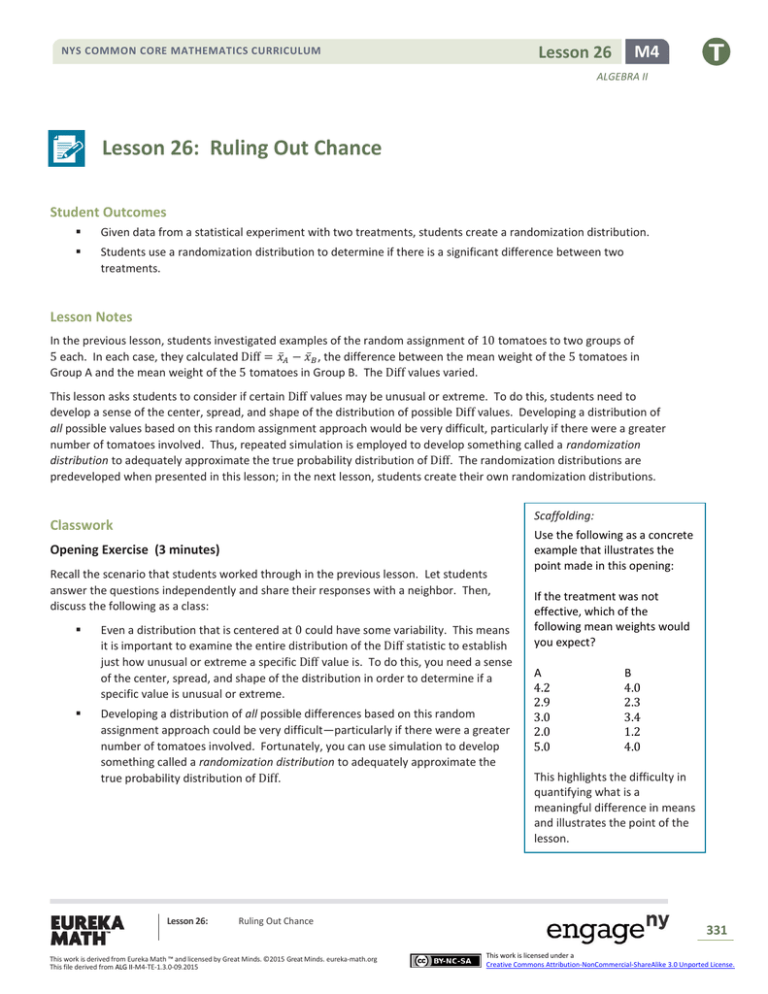
Lesson 26 NYS COMMON CORE MATHEMATICS CURRICULUM M4 ALGEBRA II Lesson 26: Ruling Out Chance Student Outcomes Given data from a statistical experiment with two treatments, students create a randomization distribution. Students use a randomization distribution to determine if there is a significant difference between two treatments. Lesson Notes In the previous lesson, students investigated examples of the random assignment of 10 tomatoes to two groups of 5 each. In each case, they calculated Diff = 𝑥̅𝐴 − 𝑥̅𝐵 , the difference between the mean weight of the 5 tomatoes in Group A and the mean weight of the 5 tomatoes in Group B. The Diff values varied. This lesson asks students to consider if certain Diff values may be unusual or extreme. To do this, students need to develop a sense of the center, spread, and shape of the distribution of possible Diff values. Developing a distribution of all possible values based on this random assignment approach would be very difficult, particularly if there were a greater number of tomatoes involved. Thus, repeated simulation is employed to develop something called a randomization distribution to adequately approximate the true probability distribution of Diff. The randomization distributions are predeveloped when presented in this lesson; in the next lesson, students create their own randomization distributions. Scaffolding: Classwork Opening Exercise (3 minutes) Recall the scenario that students worked through in the previous lesson. Let students answer the questions independently and share their responses with a neighbor. Then, discuss the following as a class: Even a distribution that is centered at 0 could have some variability. This means it is important to examine the entire distribution of the Diff statistic to establish just how unusual or extreme a specific Diff value is. To do this, you need a sense of the center, spread, and shape of the distribution in order to determine if a specific value is unusual or extreme. Developing a distribution of all possible differences based on this random assignment approach could be very difficult—particularly if there were a greater number of tomatoes involved. Fortunately, you can use simulation to develop something called a randomization distribution to adequately approximate the true probability distribution of Diff. Lesson 26: Ruling Out Chance This work is derived from Eureka Math ™ and licensed by Great Minds. ©2015 Great Minds. eureka-math.org This file derived from ALG II-M4-TE-1.3.0-09.2015 Use the following as a concrete example that illustrates the point made in this opening: If the treatment was not effective, which of the following mean weights would you expect? A 4.2 2.9 3.0 2.0 5.0 B 4.0 2.3 3.4 1.2 4.0 This highlights the difficulty in quantifying what is a meaningful difference in means and illustrates the point of the lesson. 331 This work is licensed under a Creative Commons Attribution-NonCommercial-ShareAlike 3.0 Unported License. Lesson 26 NYS COMMON CORE MATHEMATICS CURRICULUM M4 ALGEBRA II Opening Exercise Previously, you considered the random assignment of 𝟏𝟎 tomatoes into two distinct groups of 𝟓 tomatoes, Group A and ̅𝑨 − 𝒙 ̅𝑩 , the difference between the mean weight of the Group B. With each random assignment, you calculated Diff = 𝒙 𝟓 tomatoes in Group A and the mean weight of the 𝟓 tomatoes in Group B. a. Summarize in writing what you learned in the last lesson. Share your thoughts with a neighbor. In the last lesson, when the single group of observations was randomly divided into two groups, the means of these two groups differed by chance. In some cases, the difference in the means of these two groups was very small (or 𝟎), but in other cases, this difference was larger. However, in order to determine which differences were typical and ordinary versus unusual and rare, a sense of the center, spread, and shape of the distribution of possible differences is needed. b. Recall that 𝟓 of these 𝟏𝟎 tomatoes are from plants that received a nutrient treatment in the hope of growing bigger tomatoes. But what if the treatment was not effective? What difference would you expect to find between the group means? I would expect there to be no difference between the mean of Group A and the mean of Group B when performing these randomization assignments; in other words, I would expect a value of Diff equal to 0. Exercises 1–2 (7 minutes): The Distribution of Diff and Why 𝟎 Is Important Read through the beginning of the exercise, and verify that students understand the information displayed in the dot plot. Let students work with a partner on Exercises 1 and 2. Then, confirm answers as a class. Exercises 1–2: The Distribution of Diff and Why 𝟎 Is Important In the previous lesson, 𝟑 instances of the tomato randomization were considered. Imagine that the random assignment was conducted an additional 𝟐𝟒𝟕 times, and 𝟐𝟓𝟎 Diff values were computed from these 𝟐𝟓𝟎 random assignments. The results are shown graphically below in a dot plot where each dot represents the Diff value that results from a random assignment: Diff This dot plot will serve as your randomization distribution for the Diff statistic in this tomato randomization example. The dots are placed at increments of 𝟎. 𝟎𝟒 ounces. 1. Given the distribution picture above, what is the approximate value of the median and mean of the distribution? Specifically, do you think this distribution is centered near a value that implies “No Difference” between Group A and Group B? The Diff value that implies "No Difference" between Group A and Group B would be 𝟎. From visual inspection, the approximate value of the median and mean of the distribution appears to be near 𝟎, based on the near symmetry and the center of the distribution. (Note: The actual mean in this case is −𝟎. 𝟎𝟓𝟑 ounces, and the median is −𝟎. 𝟎𝟖 ounces—both just slightly below 𝟎.) Lesson 26: Ruling Out Chance This work is derived from Eureka Math ™ and licensed by Great Minds. ©2015 Great Minds. eureka-math.org This file derived from ALG II-M4-TE-1.3.0-09.2015 332 This work is licensed under a Creative Commons Attribution-NonCommercial-ShareAlike 3.0 Unported License. NYS COMMON CORE MATHEMATICS CURRICULUM Lesson 26 M4 ALGEBRA II 2. Given the distribution pictured above and based on the simulation results, determine the approximate probability of obtaining a Diff value in the cases described in (a), (b), and (c). a. Of 𝟏. 𝟔𝟒 ounces or more 𝟏𝟕 out of 𝟐𝟓𝟎 are 𝟏. 𝟔𝟒 or more. 𝟏𝟕 = 𝟎. 𝟎𝟔𝟖 = 𝟔. 𝟖% 𝟐𝟓𝟎 b. Of −𝟎. 𝟖𝟎 ounces or less 𝟔𝟗 out of 𝟐𝟓𝟎 are −𝟎. 𝟖𝟎 or less. 𝟔𝟗 = 𝟎. 𝟐𝟕𝟔 = 𝟐𝟕. 𝟔% 𝟐𝟓𝟎 c. Within 𝟎. 𝟖𝟎 ounces of 𝟎 ounces 𝟏𝟐𝟏 out of 𝟐𝟓𝟎 are between −𝟎. 𝟖𝟎 and 𝟎. 𝟖𝟎. 𝟏𝟐𝟏 = 𝟎. 𝟒𝟖𝟒 = 𝟒𝟖. 𝟒% 𝟐𝟓𝟎 d. How do you think these probabilities could be useful to people who are designing experiments? The probabilities could be used to help determine if the differences occurred by chance or not. Exercises 3–5 (15 minutes): Statistically Significant Diff Values Determining how unusual or extreme a Diff value is allows students to then consider if their experiments’ results are statistically significant. The reasoning is as follows: 5 of these 10 tomatoes are from plants that received a nutrient treatment in the hope of growing bigger tomatoes, and the other 5 received no such treatment. If the treatment was not effective, then one would generally expect there to be no difference between the mean of Group A and the mean of Group B when performing these randomization assignments; in other words, we would expect a value of Diff equal to 0. However, as seen in the previous lesson, the value of Diff varies due to chance behavior. If the difference is not the result of chance behavior, then maybe the difference did not just happen by chance alone. If the difference didn’t just happen by chance alone, maybe the difference observed in the experiment is caused by the treatment in question, which, in this case, is the nutrient. After establishing a sense of the full distribution of Diff, if the observed difference from an experiment is “extreme” (far from 0) and not typical of chance behavior, it may be considered “statistically significant” and possibly not the result of chance behavior. Keep in mind that saying statistically significant in this case means that the observed difference between two groups is not likely due to chance. Lesson 26: Ruling Out Chance This work is derived from Eureka Math ™ and licensed by Great Minds. ©2015 Great Minds. eureka-math.org This file derived from ALG II-M4-TE-1.3.0-09.2015 333 This work is licensed under a Creative Commons Attribution-NonCommercial-ShareAlike 3.0 Unported License. NYS COMMON CORE MATHEMATICS CURRICULUM Lesson 26 M4 ALGEBRA II In Exercises 3–5 and 6–8, students are asked to speculate if certain values of the Diff statistic are statistically significant. Specifically, students are told that the Diff statistic value should be considered statistically significant if there is a low probability of obtaining a result as extreme as or more extreme than the value in question. However, a “cutoff value” as to what is considered a low probability has been deliberately omitted. Ideally, students should give some thought as to what probability values might be associated with unusual events. In real-world situations, the cutoff probability value used for determining statistical significance (called a significance level) varies from situation to situation based on context; however, many introductory statistics references use a value of 0.05, or 5%, as a benchmark. Exercises 3–5: Statistically Significant Diff Values In the context of a randomization distribution that is based upon the assumption that there is no real difference between the groups, consider a Diff value of 𝑿 to be statistically significant if there is a low probability of obtaining a result that is as extreme as or more extreme than 𝑿. 3. Using that definition and your work above, would you consider any of the Diff values below to be statistically significant? Explain. a. 𝟏. 𝟔𝟒 ounces Possibly statistically significant; an event with a 𝟔. 𝟖% probability of occurring is not a very frequent occurrence. b. −𝟎. 𝟖𝟎 ounces Not statistically significant; an event with a 𝟐𝟕. 𝟔% probability of occurring is a fairly common occurrence. c. Values within 𝟎. 𝟖𝟎 ounces of 𝟎 ounces Values within 𝟎. 𝟖𝟎 ounces of 𝟎 ounces are not statistically significant; these values are not very far from 𝟎, and they are fairly common. Also, given the symmetry, if −𝟎. 𝟖𝟎 is not considered statistically significant (in part (b), above), then values that are closer to 𝟎 would also not be considered statistically significant. 4. In the previous lessons, you obtained Diff values of 𝟎. 𝟐𝟖 ounces, 𝟐. 𝟒𝟒 ounces, and 𝟎 ounces for 𝟑 different tomato randomizations. Would you consider any of those values to be statistically significant for this distribution? Explain. The values of 𝟎 and 𝟎. 𝟐𝟖 ounces would not be statistically significant based on the work above and the fact that neither value is very far from 𝟎 in the distribution. However, the value of 𝟐. 𝟒𝟒 would be statistically significant because it is very far from 𝟎 (maximum observation), and there is only a 𝟏 in 𝟐𝟓𝟎 chance (𝟎. 𝟎𝟎𝟒, or 𝟎. 𝟒% chance) of obtaining a value that extreme in this distribution. 5. Recalling that Diff is the mean weight of the 𝟓 Group A tomatoes minus the mean weight of the 𝟓 Group B tomatoes, how would you explain the meaning of a Diff value of 𝟏. 𝟔𝟒 ounces in this case? The 𝟓 tomatoes of Group A have a mean weight that is 𝟏. 𝟔𝟒 ounces higher than the mean weight of Group B’s 𝟓 tomatoes. Lesson 26: Ruling Out Chance This work is derived from Eureka Math ™ and licensed by Great Minds. ©2015 Great Minds. eureka-math.org This file derived from ALG II-M4-TE-1.3.0-09.2015 334 This work is licensed under a Creative Commons Attribution-NonCommercial-ShareAlike 3.0 Unported License. Lesson 26 NYS COMMON CORE MATHEMATICS CURRICULUM M4 ALGEBRA II Exercises 6–8 (10 minutes): The Implication of Statistically Significant Diff Values Read through the exercise as a class. Work through one or two of the Diff values in Exercise 6 as a class. Let students continue to work with their partners on the exercises. Then, confirm answers as a class. Exercises 6–8: The Implication of Statistically Significant Diff Values Keep in mind that for reasons mentioned earlier, the randomization distribution above is demonstrating what is likely to happen by chance alone if the treatment was not effective. As stated in the previous lesson, you can use this randomization distribution to assess whether or not the actual difference in means obtained from your experiment (the difference between the mean weight of the 𝟓 actual control group tomatoes and the mean weight of the 𝟓 actual treatment group tomatoes) is consistent with usual chance behavior. The logic is as follows: 6. If the observed difference is “extreme” and not typical of chance behavior, it may be considered statistically significant and possibly not the result of chance behavior. If the difference is not the result of chance behavior, then maybe the difference did not just happen by chance alone. If the difference did not just happen by chance alone, maybe the difference you observed is caused by the treatment in question, which, in this case, is the nutrient. In the context of our example, a statistically significant Diff value provides evidence that the nutrient treatment did in fact yield heavier tomatoes on average. For reasons that will be explained in the next lesson, for your tomato example, Diff values that are positive and statistically significant will be considered as good evidence that your nutrient treatment did in fact yield heavier tomatoes on average. Again, using the randomization distribution shown earlier in the lesson, which (if any) of the following Diff values would you consider to be statistically significant and lead you to think that the nutrient treatment did in fact yield heavier tomatoes on average? Explain for each case. Diff = 𝟎. 𝟒, Diff = 𝟎. 𝟖, Diff = 𝟏. 𝟐, Diff = 𝟏. 𝟔, Diff = 𝟐. 𝟎, Diff = 𝟐. 𝟒 Diff = 𝟎. 𝟒: not statistically significant; not very far from 𝟎; 𝟗𝟏 of 𝟐𝟓𝟎 values (𝟑𝟔. 𝟒%) are greater than or equal to 𝟎. 𝟒. Diff = 𝟎. 𝟖: not statistically significant; not very far from 𝟎; 𝟔𝟒 of 𝟐𝟓𝟎 values (𝟐𝟓. 𝟔%) are greater than or equal to 𝟎. 𝟖. Diff = 𝟏. 𝟐: not statistically significant; not too far from 𝟎; 𝟑𝟖 of 𝟐𝟓𝟎 values (𝟏𝟓. 𝟐%) are greater than or equal to 𝟏. 𝟐. Diff = 𝟏. 𝟔: possibly statistically significant; somewhat far from 𝟎; 𝟐𝟏 of 𝟐𝟓𝟎 values (𝟖. 𝟒%) are greater than or equal to 𝟏. 𝟔. Diff = 𝟐. 𝟎: statistically significant; very far from 𝟎; only 𝟏𝟏 of 𝟐𝟓𝟎 values (𝟒. 𝟒%) are greater than or equal to 𝟐. 𝟎. Diff = 𝟐. 𝟒: statistically significant; very far from 𝟎; only 𝟑 of 𝟐𝟓𝟎 values (𝟏. 𝟐%) are greater than or equal to 𝟐. 𝟒. 7. MP.2 In the first random assignment in the previous lesson, you obtained a Diff value of 𝟎. 𝟐𝟖 ounce. Earlier in this lesson, you were asked to consider if this might be a statistically significant value. Given the distribution shown in this lesson, if you had obtained a Diff value of 𝟎. 𝟐𝟖 ounces in your experiment and the 𝟓 Group A tomatoes had been the “treatment” tomatoes that received the nutrient, would you say that the Diff value was extreme enough to support a conclusion that the nutrient treatment yielded heavier tomatoes on average? Or do you think such a Diff value may just occur by chance when the treatment is ineffective? Explain. I would say that the Diff value of 𝟎. 𝟐𝟖 was NOT extreme enough to support a conclusion that the nutrient treatment yielded heavier tomatoes on average. Such a Diff value may just occur by chance in this case. See earlier work in Exercise 4. Also, referencing the question above, 𝟎. 𝟐𝟖 is even closer to 𝟎 than other not statistically significant values. Lesson 26: Ruling Out Chance This work is derived from Eureka Math ™ and licensed by Great Minds. ©2015 Great Minds. eureka-math.org This file derived from ALG II-M4-TE-1.3.0-09.2015 335 This work is licensed under a Creative Commons Attribution-NonCommercial-ShareAlike 3.0 Unported License. NYS COMMON CORE MATHEMATICS CURRICULUM Lesson 26 M4 ALGEBRA II In the second random assignment in the previous lesson, you obtained a Diff value of 𝟐. 𝟒𝟒 ounces. Earlier in this lesson, you were asked to consider if this might be a statistically significant value. Given the distribution shown in this lesson, if you had obtained a Diff value of 𝟐. 𝟒𝟒 ounces in your experiment and the 𝟓 Group A tomatoes had been the “treatment” tomatoes that received the nutrient, would you say that the Diff value was extreme enough to support a conclusion that the nutrient treatment yielded heavier tomatoes on average? Or do you think such a Diff value may just occur by chance when the treatment is ineffective? Explain. 8. MP.2 I would say that the Diff value of 𝟐. 𝟒𝟒 was extreme enough to support a conclusion that the nutrient treatment yielded heavier tomatoes on average. This most likely did NOT just occur by chance. See earlier work in Exercise 4. Also, referencing the question above, 𝟐. 𝟒𝟒 is even farther away from 𝟎 than other statistically significant values. Closing (5 minutes) If you were about to prepare for a debate, a court case, or some other situation where you were challenging an existing claim such as “the treatment is not effective” or “the process is not harming anyone,” what kind of probability value would you be looking for in your results before you would claim statistical significance and feel comfortable challenging the existing claim? What characteristics of the situation might influence your decision? In order to be confident in your challenge, your probability value needs to be fairly small. In the tomato example, consider that you are saying “If the nutrient was not effective, the chances of our obtaining a value this extreme in our experiment is ____; therefore, we think the nutrient must be working.” You are acknowledging that your experiment’s results could still occur a certain percent of the time even if the nutrient really did not work. If you were trying to convince an audience, a constituency, or a jury, you probably would not want to say, “There’s a 1 in 3 (33%) chance of obtaining a value this extreme.” Rather, you would want to say that the chances are “1 in 20 (5%),” or “1 in 100 (1%),” or “1 in 1,000 (0.1%).” Considerations include the amount of money and time required for sampling, the severity of the claim that is being examined, and the risks of falsely rejecting the claim of “no difference” when it was true all along, and so on. Calculate and interpret Diff = 𝑥̅𝐴 − 𝑥̅𝐵 in the following instance: Group A: 10 similar homes with insulated windows have an average monthly electric bill of $123. Group B: 10 similar homes with noninsulated windows have an average monthly electric bill of $157. The homes with insulated windows have an average monthly electric bill that is $34 less than the homes with noninsulated windows. Ask students to summarize the main ideas of the lesson in writing or with a neighbor. Use this as an opportunity to informally assess comprehension of the lesson. The Lesson Summary below offers some important ideas that should be included. Lesson 26: Ruling Out Chance This work is derived from Eureka Math ™ and licensed by Great Minds. ©2015 Great Minds. eureka-math.org This file derived from ALG II-M4-TE-1.3.0-09.2015 336 This work is licensed under a Creative Commons Attribution-NonCommercial-ShareAlike 3.0 Unported License. NYS COMMON CORE MATHEMATICS CURRICULUM Lesson 26 M4 ALGEBRA II Lesson Summary In the previous lesson, the concept of randomly separating 𝟏𝟎 tomatoes into 𝟐 groups and comparing the means of each group was introduced. The randomization distribution of the difference in means that is created from multiple occurrences of these random assignments demonstrates what is likely to happen by chance alone if the nutrient treatment is not effective. When the results of your tomato growth experiment are compared to that distribution, you can then determine if the tomato growth experiment’s results were typical of chance behavior. If the results appear typical of chance behavior and near the center of the distribution (that is, not relatively very far from a Diff value of 𝟎), then there is little evidence that the treatment was effective. However, if it appears that the experiment’s results are not typical of chance behavior, then maybe the difference you are observing didn’t just happen by chance alone. It may indicate a statistically significant difference between the treatment group and the control group, and the source of that difference might be (in this case) the nutrient treatment. Exit Ticket (5 minutes) Lesson 26: Ruling Out Chance This work is derived from Eureka Math ™ and licensed by Great Minds. ©2015 Great Minds. eureka-math.org This file derived from ALG II-M4-TE-1.3.0-09.2015 337 This work is licensed under a Creative Commons Attribution-NonCommercial-ShareAlike 3.0 Unported License. Lesson 26 NYS COMMON CORE MATHEMATICS CURRICULUM M4 ALGEBRA II Name Date Lesson 26: Ruling Out Chance Exit Ticket Medical patients who are in physical pain are often asked to communicate their level of pain on a scale of 0 to 10 where 0 means no pain and 10 means worst pain. (Note: Sometimes a visual device with pain faces is used to accommodate the reporting of the pain score.) Due to the structure of the scale, a patient would desire a lower value on this scale after treatment for pain. Diff Imagine that 20 subjects participate in a clinical experiment and that a variable of “ChangeinScore” is recorded for each subject as the subject’s pain score after treatment minus the subject’s pain score before treatment. Since the expectation is that the treatment would lower a patient’s pain score, you would desire a negative value for “ChangeinScore.” For example, a “ChangeinScore” value of −2 would mean that the patient was in less pain (for example, now at a 6, formerly at an 8). Recall that Diff = 𝑥̅𝐴 − 𝑥̅𝐵 . Although the 20 “ChangeinScore” values for the 20 patients are not shown here, below is a randomization distribution of the value Diff based on 100 random assignments of these 20 observations into two groups of 10 (Group A and Group B). 1. From the distribution above, what is the probability of obtaining a Diff value of −1 or less? Lesson 26: Ruling Out Chance This work is derived from Eureka Math ™ and licensed by Great Minds. ©2015 Great Minds. eureka-math.org This file derived from ALG II-M4-TE-1.3.0-09.2015 338 This work is licensed under a Creative Commons Attribution-NonCommercial-ShareAlike 3.0 Unported License. NYS COMMON CORE MATHEMATICS CURRICULUM Lesson 26 M4 ALGEBRA II 2. With regard to this distribution, would you consider a Diff value of −0.4 to be statistically significant? Explain. 3. a. With regard to how Diff is calculated, if Group A represented a group of patients in your experiment who received a new pain relief treatment and Group B received a pill with no medicine (called a placebo), how would you interpret a Diff value of −1.4 pain scale units in context? b. Given the distribution above, if you obtained a Diff value such as −1.4 from your experiment, would you consider that to be significant evidence of the new treatment being effective on average in relieving pain? Explain. Lesson 26: Ruling Out Chance This work is derived from Eureka Math ™ and licensed by Great Minds. ©2015 Great Minds. eureka-math.org This file derived from ALG II-M4-TE-1.3.0-09.2015 339 This work is licensed under a Creative Commons Attribution-NonCommercial-ShareAlike 3.0 Unported License. Lesson 26 NYS COMMON CORE MATHEMATICS CURRICULUM M4 ALGEBRA II Exit Ticket Sample Solutions A graphic of the Wong-Baker FACES Pain Rating Scale (as seen in many physicians’ offices) or a similar visual reference may assist students with the Exit Ticket questions. One can be found at http://pain.about.com/od/testingdiagnosis/ig/pain-scales/Wong-Baker.htm. Medical patients who are in physical pain are often asked to communicate their level of pain on a scale of 𝟎 to 𝟏𝟎 where 𝟎 means no pain and 𝟏𝟎 means worst pain. (Note: Sometimes a visual device with pain faces is used to accommodate the reporting of the pain score.) Due to the structure of the scale, a patient would desire a lower value on this scale after treatment for pain. Diff Imagine that 𝟐𝟎 subjects participate in a clinical experiment and that a variable of “ChangeinScore” is recorded for each subject as the subject’s pain score after treatment minus the subject’s pain score before treatment. Since the expectation is that the treatment would lower a patient’s pain score, you would desire a negative value for “ChangeinScore.” For example, a “ChangeinScore” value of −𝟐 would mean that the patient was in less pain (for example, now at a 𝟔, formerly at an 𝟖). ̅𝑨 − 𝒙 ̅𝑩 . Although the 𝟐𝟎 “ChangeinScore” values for the 𝟐𝟎 patients are not shown here, below is a Recall that Diff = 𝒙 randomization distribution of the value Diff based on 𝟏𝟎𝟎 random assignments of these 𝟐𝟎 observations into two groups of 𝟏𝟎 (Group A and Group B). 1. From the distribution above, what is the probability of obtaining a Diff value of −𝟏 or less? 𝟏𝟏 𝟏𝟎𝟎 2. = 𝟎. 𝟏𝟏, which is 𝟏𝟏% With regard to this distribution, would you consider a Diff value of −𝟎. 𝟒 to be statistically significant? Explain. No. The value is not far from 𝟎, and 𝟒𝟐 of the 𝟏𝟎𝟎 values in the distribution are at or below −𝟎. 𝟒. 3. a. With regard to how Diff is calculated, if Group A represented a group of patients in your experiment who received a new pain relief treatment and Group B received a pill with no medicine (called a placebo), how would you interpret a Diff value of −𝟏. 𝟒 pain scale units in context? The group that received the pain relief treatment had an average reduction in pain that was 𝟏. 𝟒 units better (lower) than the group that received the placebo. b. Given the distribution above, if you obtained Diff value such as −𝟏. 𝟒 from your experiment, would you consider that to be significant evidence of the new treatment being effective on average in relieving pain? Explain. Yes. −𝟏. 𝟒 is far from 𝟎, and the probability of obtaining a Diff value of −𝟏. 𝟒 or less is only 𝟒%. The value provides evidence that the new treatment may be effective in relieving pain. Lesson 26: Ruling Out Chance This work is derived from Eureka Math ™ and licensed by Great Minds. ©2015 Great Minds. eureka-math.org This file derived from ALG II-M4-TE-1.3.0-09.2015 340 This work is licensed under a Creative Commons Attribution-NonCommercial-ShareAlike 3.0 Unported License. Lesson 26 NYS COMMON CORE MATHEMATICS CURRICULUM M4 ALGEBRA II Problem Set Sample Solutions In each of the 𝟑 cases below, calculate the Diff value as directed, and write a sentence explaining what the Diff value means in context. Write the sentence for a general audience. 1. ̅𝑨 = −𝟖. Group A: 𝟖 dieters lost an average of 𝟖 pounds, so 𝒙 ̅𝑩 = −𝟐. Group B: 𝟖 nondieters lost an average of 𝟐 pounds over the same time period, so 𝒙 ̅𝑨 − 𝒙 ̅𝑩 . Calculate and interpret Diff = 𝒙 ̅𝑨 − 𝒙 ̅𝑩 = −𝟖 − (−𝟐) = −𝟔. The 𝟖 dieters lost an average of 𝟔 pounds more than the 𝟖 nondieters. Diff = 𝒙 2. Group A: 𝟏𝟏 students were on average 𝟎. 𝟒 seconds faster in their 𝟏𝟎𝟎-meter run times after following a new training regimen. Group B: 𝟏𝟏 students were on average 𝟎. 𝟐 seconds slower in their 𝟏𝟎𝟎-meter run times after not following any new training regimens. ̅𝑨 − 𝒙 ̅𝑩 . Calculate and interpret Diff = 𝒙 Diff = −𝟎. 𝟒 − 𝟎. 𝟐 = −𝟎. 𝟔. The 𝟏𝟏 students following the new training regimen were on average 𝟎. 𝟔 seconds faster in their 𝟏𝟎𝟎-meter run times than the 𝟏𝟏 students not following any new training regimens. 3. Group A: 𝟐𝟎 squash that have been grown in an irrigated field have an average weight of 𝟏. 𝟑 pounds. Group B: 𝟐𝟎 squash that have been grown in a nonirrigated field have an average weight of 𝟏. 𝟐 pounds. ̅𝑨 − 𝒙 ̅𝑩 . Calculate and interpret Diff = 𝒙 Diff = 𝟏. 𝟑 − 𝟏. 𝟐 = 𝟎. 𝟏. The 𝟐𝟎 squash grown in an irrigated field have an average weight that is 𝟎. 𝟏 pound higher than the 𝟐𝟎 squash grown in a nonirrigated field. 4. Using the randomization distribution shown below, what is the probability of obtaining a Diff value of −𝟎. 𝟔 or less? Diff 𝟐𝟗 𝟏𝟎𝟎 5. = 𝟎. 𝟐𝟗, which is 𝟐𝟗% Would a Diff value of −𝟎. 𝟔 or less be considered a statistically significant difference? Why or why not? No. −𝟎. 𝟔 is not far from 𝟎, and the probability of obtaining a Diff value of −𝟎. 𝟔 or less is 𝟐𝟗%. Lesson 26: Ruling Out Chance This work is derived from Eureka Math ™ and licensed by Great Minds. ©2015 Great Minds. eureka-math.org This file derived from ALG II-M4-TE-1.3.0-09.2015 341 This work is licensed under a Creative Commons Attribution-NonCommercial-ShareAlike 3.0 Unported License. NYS COMMON CORE MATHEMATICS CURRICULUM Lesson 26 M4 ALGEBRA II 6. Using the randomization distribution shown in Problem 4, what is the probability of obtaining a Diff value of −𝟏. 𝟐 or less? The probability of obtaining a Diff value of −𝟏. 𝟐 or less is 𝟔 out of 𝟏𝟎𝟎, or 𝟔%. 7. Would a Diff value of −𝟏. 𝟐 or less be considered a statistically significant difference? Why or why not? Possibly statistically significant. −𝟏. 𝟐 is far from 𝟎, and the probability of obtaining a Diff value of −𝟏. 𝟐 or less is only 𝟔%. The value provides evidence that the new treatment may be effective in relieving pain. Lesson 26: Ruling Out Chance This work is derived from Eureka Math ™ and licensed by Great Minds. ©2015 Great Minds. eureka-math.org This file derived from ALG II-M4-TE-1.3.0-09.2015 342 This work is licensed under a Creative Commons Attribution-NonCommercial-ShareAlike 3.0 Unported License.
